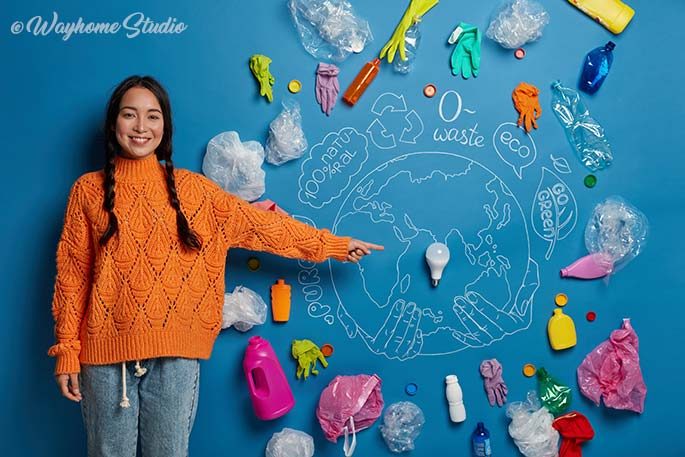
Businesses recycle for different reasons. Some companies may start recycling due to legal requirements, branding strategies, or as part of a conscious effort to cause less environmental harm. While recycling is highly encouraged among businesses, several inefficiencies may arise during the process. One of those routine inefficiencies is recycling contamination, an unfortunately common occurrence across many industries.
Recycling contamination describes any scenario where non-recyclable materials are processed inaccurately, which corrupts other recyclable items nearby. Every year, countless businesses must discard their perfectly recyclable materials due to contamination. Not only does contamination reduce recycling profitability, but it also contributes more waste to our landfills. Worst of all, recycling contamination is easily avoidable and entirely unnecessary.
There are many ways that recycling contamination can manifest. In businesses, most contamination occurs due to improper storage, handling, or transportation of materials. However, it isn’t something that happens maliciously. Often, employees are misinformed about recycling guidelines, leading to mix-ups and mistakes in separating the materials.
From a business perspective, contamination adds an unnecessary expense to the recycling process. Let’s examine the cost of recycling contamination for businesses and how they can minimize this issue:
What is recycling contamination?
Recycling occurs through a division of materials. Paper gets sorted with other paper materials, glass goes with other glass items, and so forth. Modern recycling bins follow this concept, specifically designed to sort the materials into separate categories. Businesses can use multiple containers to isolate their recyclable materials correctly without mixing up the collections.
Recycling contamination happens when the wrong material gets added to a collection. A typical example is when food waste and beverage spills ruin an entire bin’s worth of recyclable materials, rendering it unusable. Similarly, another example is when cardboard gets stained with grease (like a pizza box), making it no longer recyclable.
The most common contaminants in recycling include:
- Plastic bags
- Food waste
- Frozen food containers
- Unrecyclable beverage cartons
- Grease-stained cardboard
- Wrong types of plastic
- Hazardous waste (like paint or pesticide)
What happens when recycling is contaminated?
When done correctly, recycling is an efficient and straightforward procedure. However, contamination complicates the processing of recyclable materials, forcing companies to exert more time and effort to correct the problem. In dramatic cases, severe recycling contamination leads to some plants shutting down temporarily to do away with the backlog. The past few years have seen numerous plants across North America halting operations to tackle contamination issues.
If your business is a common perpetrator of recycling contamination, there’s going to be tension between you and your waste management company. In some cases, certain facilities might refuse to accept contaminated recycling from repeat offenders. It puts your company in a tough spot as you scramble to find an alternative provider for your discarded materials.
Unfortunately, recycling contamination is an easy mistake. Some estimates suggest as much as 25% of recycling gets contaminated. That means there might be contamination in every one of four recycling bins. However, the good news is that businesses can reduce the impact of recycling contamination. With planning and coordination, you can keep the likelihood of contamination to a minimum.
Cost of recycling contamination
Recycling contamination comes with a hefty cost for businesses. Notably, contamination decreases the amount of recycling that gets resold as exports. Many companies make money by processing recyclable materials, selling them to manufacturers, and redeveloping them into new products. However, recycling exports have fallen in recent years, partially due to contamination.
Recently, total scrap plastic exports from the US have been chopped nearly in half due to the country’s high recycling contamination rates. Similar problems are happening with different exports worldwide. Certain countries have gone so far as to ban certain materials from being accepted because the recycling contamination affected the quality.
Although the decline in exports doesn’t stem exclusively from recycling contamination, it plays a significant factor. When goods made from recyclable materials don’t meet the quality threshold, the company is affected negatively. The cost of recycling contamination might lead to refunds, wasted resources, and unsatisfactory business transactions.
How to decrease contamination of recycling
Fortunately, companies can take initiatives to decrease contamination levels in their recycling. Start by raising awareness in the company, reminding employees about the importance of sorting their materials into the correct collections. Place relevant recycling containers at convenient locations around your facility and ensure your staff knows the differences between the bins.
Furthermore, clean the recycling containers frequently and thoroughly. Your goal is to clear away any contaminants like liquids, oils, grease, and food waste. Most of the time, a routine wash and rinse will do the trick. If anything gets stuck, try shaking the bins until the residue becomes dislodged. With these best practices, your company can commit to effective recycling management, as recycling contamination becomes an issue of the past!




































































































































 Three Ways to Engage Teams and Clients to Maximize Your Recycling Program Engagement
Three Ways to Engage Teams and Clients to Maximize Your Recycling Program Engagement  How to Integrate Accessibility Into Your Sustainability Planning
How to Integrate Accessibility Into Your Sustainability Planning  Why Park Benches Can Promote Workplace Well-Being
Why Park Benches Can Promote Workplace Well-Being 
